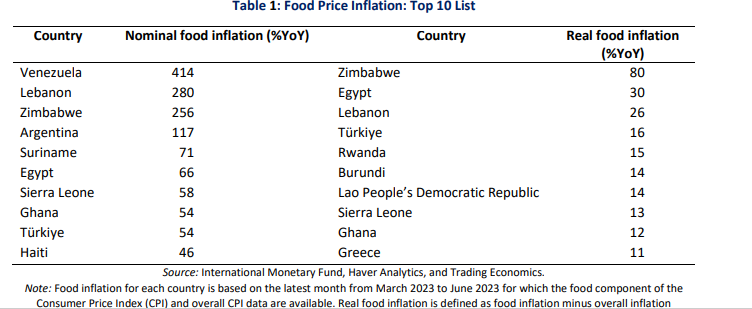Ghana ranks among top 10 nations with highest food inflation
)
The country's Nominal Food Inflation, a year-on-year metric, surged to 54%, earning it the eighth rank. Meanwhile, its Real Food Inflation of 12% positioned Ghana at ninth place.
In the category of Nominal Food Inflation, Venezuela dominated the charts with an alarming year-on-year inflation rate of 414%. Lebanon followed closely with 280%, trailed by Zimbabwe (256%), Argentina (117%), Suriname (71%), Egypt (66%), and Sierra Leone (58%) in second through seventh positions respectively.
When evaluating Real Food Inflation, Zimbabwe (80%), Egypt (30%), Lebanon (26%), Turkey (16%), Rwanda (15%), Burundi (14%), Lao (14%), and Sierra Leone (13%) emerged as the frontrunners in the first eight positions.
The Food Security Report, spanning from February 2023 to May 2023 and analyzing available food price inflation data, spotlighted the prevalence of high inflation rates in numerous low- and middle-income nations. Notably, over 5% inflation was recorded in 63.2% of low-income countries, 79.5% of lower-middle-income countries, and 67.0% of upper-middle-income countries, with many experiencing double-digit inflation.
In the high-income bracket, 78.9% of countries were also affected by elevated food price inflation. The impacts were widespread across regions including Africa, North America, Latin America, South Asia, Europe, and Central Asia.
Furthermore, the report highlighted that food price inflation surpassed overall inflation (measured by the year-on-year change in the Consumer Price Index) in 80.1% of the 166 countries for which both food CPI and overall CPI indexes were available.

The report detailed a notable increase in maize and wheat prices, surging by 12% and 14% respectively after declining in the first half of July 2023. This surge significantly contributed to the escalation of the cereal price index. Conversely, rice prices remained stable during this period.
Comparatively, maize and wheat prices were 15% and 17% lower on a year-on-year basis, while rice prices surged by 16%. When measured against January 2021, maize, wheat, and rice prices marked increases of 8%, 11%, and 3% respectively.
In addition to the food inflation insights, the 2023 State of Food Insecurity and Nutrition in the World report underscored the state of global hunger, food insecurity, and the implications of urbanization within agrifood systems.
The report also expressed concerns about Russia's withdrawal from the Black Sea Grain Initiative (BSGI) within global markets.
)
)
)
)
)
)